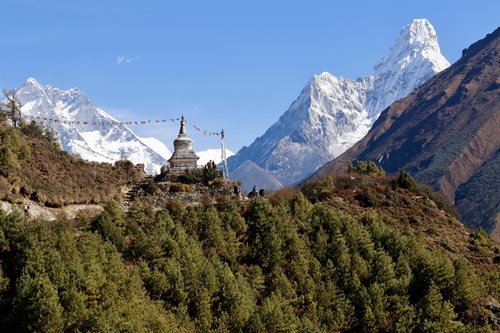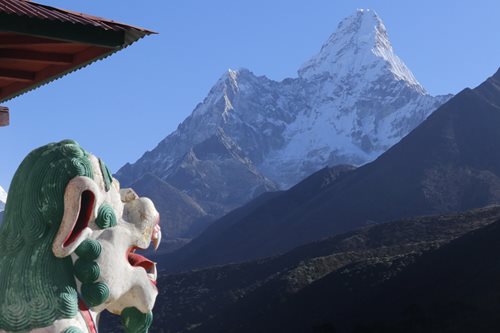Our trip to the Everest region didn’t disappoint but with mere words or even photos it is hard to conjure the grandeur of the mighty mountains and their eternal snows! I’ve already written of my favourite minor peaks (click
Heightist?) and so maybe you’ve already guessed that I don’t find Everest beautiful. It is lumpish: a slightly squat pyramid; the summits all around eclipse it in looks, but how it has inspired adventurers to risk everything to be able to stand on the very highest point on earth!
The conditions up high are so challenging that one member of Mallory’s expedition nearly choked to death as his frost-bitten trachea sloughed off and all but asphyxiated him.
 |
| The trail to Everest basecamp goes through lovely rhododendron, pine and juniper forest |
 |
| Everest is the peak on the far left; Tangboche village is on the ridge mid-picture |
These days, I'm not made of the tough stuff of such driven expeditionaries and long ago decided my knees weren't up to another major trek but how could I leave Nepal after 10 years without getting close to Chomolungma herself? The answer was to take one of the ‘microbuses of the Khumbu’ thus avoiding the nastiest ascents. There are plenty and the skies are busy. Most are four-seaters and when not ferrying the unfit or the injured, they carry cargoes of timber, plywood or fuel or heaven-knows-what. Tenzing, a hyperactive chap with a manic giggle, explained in Nepali about ceilings dangling beneath then aircraft. We realised he’d used an English word amidst his fast-spoken Nepali but it took a while to realise he was talking of slings (pronounced see-lings) beneath the helicopter, nor plywood ceilings for new homes. Lots of Nepalis find it difficult to pronounce certain double consonants together so manage by adding an ee sound to say e-school and e-stick.
This trip was my first experience of heli-travel and it was awe-inspiring! I’m not especially nervous of flying but I don’t enjoy heights much. I did a couple of parachute jumps thinking it might help my vertigo, but reckon it made things worse as I could imagine jumping off cliffs and crags. And the view in small helicopter is so unimpeded that I felt very exposed and not a little scared, pondering one how they do tend to crash a lot more than light aircraft!
There was a going-over-a-bridge feeling in the guts at take-off and as the aircraft moves forward and the mountainside falls away there is a dizzying feeling of falling. Then the only other concern was how close pilots choose to fly to various cliffs and valley-sides. It felt as if I could have grabbed some grass on the way past. But how great it was to sit in comfort recalling how I’d struggled breathlessly along dusty paths all the way to Pangboche at 3985m above sea level.
The weather was good so we only had to wait an hour to board our Czech-made 18-seater plane for our return flight to Kathmandu. It is the landings that are dangerous here so I was relaxed as we took to the air again. Flying in these little propeller-driven aircraft, it is impressive to see the pilot's display screen and note how he is navigating BELOW many of the hill tops, tacking along valleys and nipping over ridges... which induce breezes and turbulence that rock the plane.
Unnervingly on several occasions on this flight we heard loud 'Terrane - PULL UP, PULL UP' from the cockpit as we flew one ridge or another. There was plenty of airspace but I guess we were less than 100m above solid ground and the guy in the seat next to me (across the aisle) seemed very unhappy, and looked as if he might have been praying.
Happily, we all lived to tell the tale.
 |
| The beautiful mountain of Ama Dablam from Tengboche monastery |
 |
| A 'Khumbu microbus' unloading food, then we'll climb aboard; note the frost on the ground |